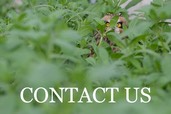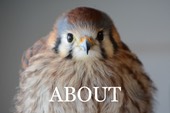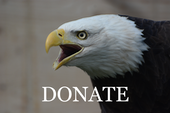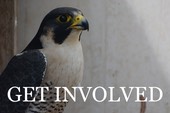Cooler Temperatures and Fewer Birds
Cooler temperatures and a decrease in caseload are both welcome changes, but we still aren’t bored. In addition to two more Great Horned Owls and two Cooper’s Hawks, we are treating a Common Nighthawk with injuries to its left shoulder and right wrist.

There is a Blue Grouse with a broken leg.

And another nestling Barn Swallow! Good grief, shouldn’t baby season be over? It will be more than a week before this little one is self feeding. Hopefully he will be ready to release in time for fall migration.

Emaciated Bald Eagle
The saddest case this week was a one-year old emaciated Bald Eagle. The eagle had dislocated his right shoulder, probably two or three weeks earlier, and had been unable to fly or find food during that time. At 1.99 kilograms, he was 50% under the normal weight for a male Bald Eagle of 4.12 kg. His initial packed cell volume, indicating the percentage of red blood cells in his blood, was 23.5. After three days of hydration, that number had dropped to 14.5, a more accurate measurement, but far below the normal low to mid-40’s range. The initial PCV was artificially elevated due to his extreme dehydration.
He died later that day. There may have been too much damage to various organs due to starvation, or there may have been complicating factors. We will send a blood sample off to test for West Nile Virus after the holiday.

A Happy Ending For Two Birds
Fortunately there were happy endings for two birds. The tiny fledgling Flammulated Owl spent two weeks gaining weight (41 grams to 63 grams) and perfecting her flight. She was very ready to return to the Blue Mountains of eastern Oregon! After a few seconds to survey the surroundings, she was off like a shot.

Every release is a victory, but the Pelican release was even more satisfying. An American White Pelican was admitted two months ago after being found floundering in the Yakima River. It was tangled in fishing line with large tears in both wings. The line wrapped around the left wing still had a fish attached to it. The right wing healed within two weeks. The tissue damage in the left wing was extensive and it took more than a month to heal.

Because of all the tissue damage, we weren’t sure if the Pelican would be able to fly and didn’t have a suitable space for a test flight. After consulting with the USFWS at McNary Wildlife Refuge about a suitable release site for a nonflighted Pelican, we headed for Slough #2. The bird quickly swam out to the middle of the slough, saw a flock of Pelicans in the distance and immediately took flight! The flight was graceful and perfect. What a satisfying release!








